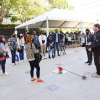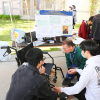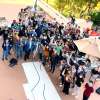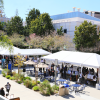Winter Design Review Returns to Engineering Gateway Plaza

April 8, 2022 - It was a welcome scene Friday, March 11, as engineering seniors converged on Engineering Gateway Plaza to present their capstone design projects at the 2022 Winter Design Review. More than 1,000 students participated, showcasing 190 projects at the annual event, which because of the large numbers was divided into two sessions.
The senior design program provides students with hands-on learning experience and professional development through innovative projects that bridge academic fundamentals with real-world challenges. After working in teams on their projects for two quarters, students are then able to present their ideas by displaying or demonstrating them to a wider audience at Winter Design Review.
The morning session, from 10 to 11: 30 a.m., included teams from electrical engineering and computer science, and chemical and biomolecular engineering. The afternoon session, 2 to 3:30 p.m., highlighted biomedical engineering and materials science, civil and environmental engineering, and mechanical and aerospace engineering.
“I love that we are here in person for Winter Design Review,” said Magnus Egerstedt, dean of the Samueli School of Engineering. “This is where the rubber meets the road. I invite our guests to check out all the innovative ideas from our student teams and challenge them with tough questions.”
A couple dozen industry guests along with faculty and staff browsed the projects and visited with students. Projects included devices to assist people who are visually impaired, ways to scale up growth of E. coli and thereby production of insulin for people with diabetes, and best options for treatment of water containing long-lasting PFAS chemicals in groundwater well design.
There were 10 teams that attempted to build an autonomous flight project proposed by Stuart Kleinfelder, professor of electrical engineering and computer science. The project, modeled after the VertiBird children’s toy from the 1970s, demanded a multitude of skills such as computer-aided design, 3D printing, electronics, programming, machine learning, inertial navigation and more. It turned out to be quite a challenge for the teams, as well as the instructor.
“It was a more difficult project than I had anticipated. I built it myself and barely got it to work,” said Kleinfelder. “However, it was a fun one, as all teams who got anywhere have said to me. Even though few teams got to the point of autonomous flight, they all learned a great deal.”
As with real-world engineering projects, there were setbacks and challenges. “It was hard to get the software just right in order for it to fly,” said Nathaniel Aponte, who worked on the autonomous flight project, “but it was fun working on it.”
His teammate Anthony Verburg thought the mechanical part was tricky. “The motor kept unscrewing from the base due to the vibration. We learned a lot,” he said.
Near the end of each session, Egerstedt announced the Dean’s Choice Award winners. The annual awards are based on department nominations using the following criteria: Does it solve a grand challenge problem? Can it lead to commercialization, or is it viable and practical? Is it cool: What’s the wow factor? This year, there were 16 winners, and their posters will be exhibited in the Science Library in April.
While the seniors were showcasing their work on the upper Gateway Plaza, first-year students were busy testing and competing with their autonomous rovers on the lower plaza, near Engineering Tower. This group contest was a culmination of the Introduction to Engineering class taught by instructors Lawrence Kulinsky and Lily Wu. The winter quarter class had 187 students in the autonomous rover project, 38 students in the fitness tracker project and 20 students in the autonomous microfluidic concentration detection project. The winner of the main project, autonomous rover, was Team Jaws, consisting of students Salimata Kere, Ethan Thomas Lovin, Nathan Edward Martinez, Kay Morse, Nathalie Najjar and Diego Perez. The team autonomously drove their rover by using light sensors to follow a line and then picked up a red object by using color recognition, all in 9.5 seconds.
To view photos of Winter Design Review, see our Facebook pages:
Morning session: https://www.facebook.com/media/set/?set=a.10159678155247350&type=3
Afternoon session: https://www.facebook.com/media/set/?set=a.10159678164627350&type=3
2022 Dean’s Choice Awards
BME/MSE
Fluid Packs for Pediatrics Intravenous Fluids
This project addresses the challenge many parents face, where they want their children to be able to run, jump and play, while still being safe and attached to their IV and TPN lines. In collaboration with CHOC and Cedars-Sinai at Georgetown and through extensive engineering and design, the students have developed a way to provide children with a portable TPN and IV backpack that can fit the current commercial devices used in the clinic. They plan to license this accessory directly to TPN manufacturers for children.
Assistive Device for Floor-to-Wheelchair Transfer
In collaboration with the nonprofit Free Wheelchair Mission, the BME students have developed an extremely low cost and practical device for floor-to-wheelchair transfers. They plan to work directly with the nonprofit organization, and through a novel social awareness business model (i.e., TOMS business model), they intend to make these devices available for free to those in need in developing countries while also selling the devices in the U.S.
CBE
Catalase: Breaking the Bad
This team has rigorously characterized beta-galactosidase and extrapolated its activity to the production of lactose-free milk, a high-volume product in the dairy market.
This Exchange Will Resin-ate With You: Effect of Flow Rate and Resin Bed Height on Resin Exchange Capacity
This team has characterized a water-softening process and applied it to the Irvine Ranch Water District (IRWD) water treatment facility.
Investigating Temperature Effects on Both Aerobic and Anaerobic Batch Growth of E. coli
These students have investigated the effect of temperature and presence of oxygen on growth of E. coli, and scaled up their results to estimate the volume of reactors necessary to produce sufficient insulin for people with diabetes in Irvine.
CEE
Aquatic and Recreation Center Design
The approximately 17,000 square feet Aquatic and Recreation Center will include multisport indoor courts constructed over an automated parking garage and two rooftop Olympic-size swimming pools. The structure will have bridges connecting to the adjacent city recreation administration office facility. The rooftop pools will be located over the column-free intervarsity size basketball or volleyball courts. Massive steel trusses will be designed to support the elevated pools. The multisport floors will consist of two-way concrete flat slabs spanning over columns in the ground-floor garage. The foundation system will consist of spread footings. The lateral force-resisting system will be special frame concrete shear walls.
Groundwater Well Design and PFAS Treatment
This project involves the creation of a groundwater well for South Montebello Irrigation District for municipal water use, and includes a treatment facility to reduce PFOA and PFOS levels found in the water. Three different types of PFAS treatment are considered to find the best fit for the district: reverse osmosis, granular activated carbon and ion exchange resin. Ion exchange resin is currently the most attractive solution due to its low empty bed contact time and its ability to target specific PFAS.
EECS
Eye of Aurora
Eye of Aurora is an attempt to help people with blindness see their surroundings. Aurora differs from other assists for the blind in that it’s less about mere navigation, such as obstacle avoidance, and more about communicating the possibilities and beauty of the visual world to those without sight. Machine learning is used in this process through a highly integrated pair of camera-equipped glasses.
The Power of Glove
This project attempts to enable a “Minority Report” style of computer interaction, in which hand gestures substitute for keyboard and mouse use. Carpal tunnel syndrome and other injuries due to chronic stereotyped motions are avoided and replaced with more fluid gestures in space. The commercial possibilities of such systems are strong, as is the potential to reduce suffering.
Project Seaweed
Project Seaweed attempts to produce a remotely operated submersible that can assist kelp farmers and re-foresters. Kelp farmers are often limited to operating close to the shoreline due to risks to divers, and kelp farmers struggle with the time, training, and costs of planting kelp. An inexpensive, flexible, remotely operated submersible could help feed millions and restore damaged habitats.
ZotPonics v3.0: A Smart and Scalable Hydroponics Network
This project looks at sustainable food growing and consumption for urban dwellers. The team has received both student organization and UROP funding. They have installed a working prototype at the UCI Fresh Hub. A multi-year project (graduating seniors trained incoming seniors), the students have continually improved the prototype from a single shelf to multiple shelves with app connectivity. This is the inaugural year the team has installed the shelf at the UCI Fresh Hub so they can begin growing food for other students while advocating for green technology and sustainable living.
Blind Assist Vest
The team has built a working prototype of a vest to help visually impaired persons navigate and interact with the environment around them. The vest is functional as well as cheaper than existing commercial products. This project combines a lot of the engineering concepts students learn in their upper division classes in a practical application with an emphasis on helping others.
MAE
Fastener-less Flange
Relativity Space has sponsored this team to develop the future of flanges (the method for temporary connection of two pipes), specifically for use in their 3D-printed rockets.
Prosthetic Thumb
The team designed and prototyped a prosthetic thumb for people who retain portions of fingers on their right hand and have had their left arm and both feet amputated. This prosthesis will help them accomplish everyday tasks that they currently cannot, such as eating with a utensil and buttoning a shirt.
UAV Forge
This team designed an unmanned aerial vehicle (UAV) capable of autonomous flight and navigation while avoiding dynamic obstacles and detecting, localizing, and classifying objects. The system must also airdrop a ground vehicle that autonomously delivers a payload.
UCI CanSat / AntSat
The CanSat team competes in a design-build-fly competition that reflects a real-world aerospace mission that includes telemetry requirements, communications and autonomous operations. The CanSat is launched to an altitude of about 700 meters where it deploys both a science payload and accompanying container. It then goes through two descent phases with particular velocity requirements before releasing a 10-meter-long tethered payload within 20 seconds. The payload must maintain video camera feed with a particular pose and orientation. During all portions of the mission, the payload and container must record environmental data from onboard sensors and stream it in real time to a ground station computer.
– Lori Brandt





